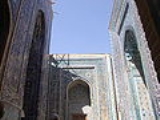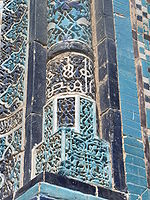
Shah-i-Zinda
Encyclopedia
Shah-i-Zinda is a necropolis
in the north-eastern part of Samarkand
, Uzbekistan
.
The Shah-i-Zinda Ensemble includes mausoleums and other ritual buildings of 9-14th and 19th centuries. The name Shah-i-Zinda (meaning "The living king") is connected with the legend that Kusam ibn Abbas, the cousin of the prophet Muhammad
was buried there. As if he came to Samarkand with the Arab invasion in the 7th century to preach Islam
. Popular legends speak that he was beheaded for his faith. But he took his head and went into the deep well (Garden of Paradise), where he's still living now.
The Shah-i-Zinda complex was formed over nine (from 11th till 19th) centuries and now includes more than twenty buildings.
 The ensemble comprises three groups of structures: lower, middle and upper connected by four-arched domed passages locally called chartak. The earliest buildings date back to the 11-12th centuries. Mainly their bases and headstones have remained now. The most part dates back to the 14-15th centuries. Reconstructions of the 16-19th centuries were of no significance and did not change the general composition and appearance.
The ensemble comprises three groups of structures: lower, middle and upper connected by four-arched domed passages locally called chartak. The earliest buildings date back to the 11-12th centuries. Mainly their bases and headstones have remained now. The most part dates back to the 14-15th centuries. Reconstructions of the 16-19th centuries were of no significance and did not change the general composition and appearance.
The initial main body - Kusam-ibn-Abbas complex - is situated in the northeastern part of the ensemble. It consists of several buildings. The most ancient of them, the Kusam-ibn-Abbas mausoleum and mosque
(16th century), are among them.
The upper group of buildings consists of three mausoleums facing each other. The earliest one is Khodja-Akhmad Mausoleum (1340s), which completes the passage from the north. The Mausoleum of 1361, on the right, restricts the same passage from the east.
 The middle group consists of the mausoleums of the last quarter of the 14th century - first half of the 15th century and is concerned with the names of Timur
The middle group consists of the mausoleums of the last quarter of the 14th century - first half of the 15th century and is concerned with the names of Timur
's relatives, military and clergy aristocracy. On the western side the Mausoleum of Shadi Mulk Aga, the niece of Timur, stands out. This portal-domed one-premise crypt was built in 1372. Opposite is the Mausoleum of Shirin Bika Aga, Timur's sister.
Next to Shirin-Bika-Aga Mausoleum is the so-called Octahedron, an unusual crypt of the first half of the 15th century.
Near the multi-step staircase the most well proportioned buildings of the lower group is situated. It is a double-cupola mausoleum of the beginning of the 15th century. This mausoleum is devoted to Kazi Zade Rumi, who was the scientist and astronomer. Therefore the double-cupola mausoleum which was built by Ulugbek above his tomb in 1434-1435th has the height comparable with cupolas of the royal family's mausoleums.
The main entrance gate to the ensemble (Darvazakhana or the first chartak) turned southward was built in 1434-1435 under Ulugbek.
Necropolis
A necropolis is a large cemetery or burial ground, usually including structural tombs. The word comes from the Greek νεκρόπολις - nekropolis, literally meaning "city of the dead"...
in the north-eastern part of Samarkand
Samarkand
Although a Persian-speaking region, it was not united politically with Iran most of the times between the disintegration of the Seleucid Empire and the Arab conquest . In the 6th century it was within the domain of the Turkic kingdom of the Göktürks.At the start of the 8th century Samarkand came...
, Uzbekistan
Uzbekistan
Uzbekistan , officially the Republic of Uzbekistan is a doubly landlocked country in Central Asia and one of the six independent Turkic states. It shares borders with Kazakhstan to the west and to the north, Kyrgyzstan and Tajikistan to the east, and Afghanistan and Turkmenistan to the south....
.
The Shah-i-Zinda Ensemble includes mausoleums and other ritual buildings of 9-14th and 19th centuries. The name Shah-i-Zinda (meaning "The living king") is connected with the legend that Kusam ibn Abbas, the cousin of the prophet Muhammad
Muhammad
Muhammad |ligature]] at U+FDF4 ;Arabic pronunciation varies regionally; the first vowel ranges from ~~; the second and the last vowel: ~~~. There are dialects which have no stress. In Egypt, it is pronounced not in religious contexts...
was buried there. As if he came to Samarkand with the Arab invasion in the 7th century to preach Islam
Islam
Islam . The most common are and . : Arabic pronunciation varies regionally. The first vowel ranges from ~~. The second vowel ranges from ~~~...
. Popular legends speak that he was beheaded for his faith. But he took his head and went into the deep well (Garden of Paradise), where he's still living now.
The Shah-i-Zinda complex was formed over nine (from 11th till 19th) centuries and now includes more than twenty buildings.

The initial main body - Kusam-ibn-Abbas complex - is situated in the northeastern part of the ensemble. It consists of several buildings. The most ancient of them, the Kusam-ibn-Abbas mausoleum and mosque
Mosque
A mosque is a place of worship for followers of Islam. The word is likely to have entered the English language through French , from Portuguese , from Spanish , and from Berber , ultimately originating in — . The Arabic word masjid literally means a place of prostration...
(16th century), are among them.
The upper group of buildings consists of three mausoleums facing each other. The earliest one is Khodja-Akhmad Mausoleum (1340s), which completes the passage from the north. The Mausoleum of 1361, on the right, restricts the same passage from the east.

Timur
Timur , historically known as Tamerlane in English , was a 14th-century conqueror of West, South and Central Asia, and the founder of the Timurid dynasty in Central Asia, and great-great-grandfather of Babur, the founder of the Mughal Dynasty, which survived as the Mughal Empire in India until...
's relatives, military and clergy aristocracy. On the western side the Mausoleum of Shadi Mulk Aga, the niece of Timur, stands out. This portal-domed one-premise crypt was built in 1372. Opposite is the Mausoleum of Shirin Bika Aga, Timur's sister.
Next to Shirin-Bika-Aga Mausoleum is the so-called Octahedron, an unusual crypt of the first half of the 15th century.
Near the multi-step staircase the most well proportioned buildings of the lower group is situated. It is a double-cupola mausoleum of the beginning of the 15th century. This mausoleum is devoted to Kazi Zade Rumi, who was the scientist and astronomer. Therefore the double-cupola mausoleum which was built by Ulugbek above his tomb in 1434-1435th has the height comparable with cupolas of the royal family's mausoleums.
The main entrance gate to the ensemble (Darvazakhana or the first chartak) turned southward was built in 1434-1435 under Ulugbek.

